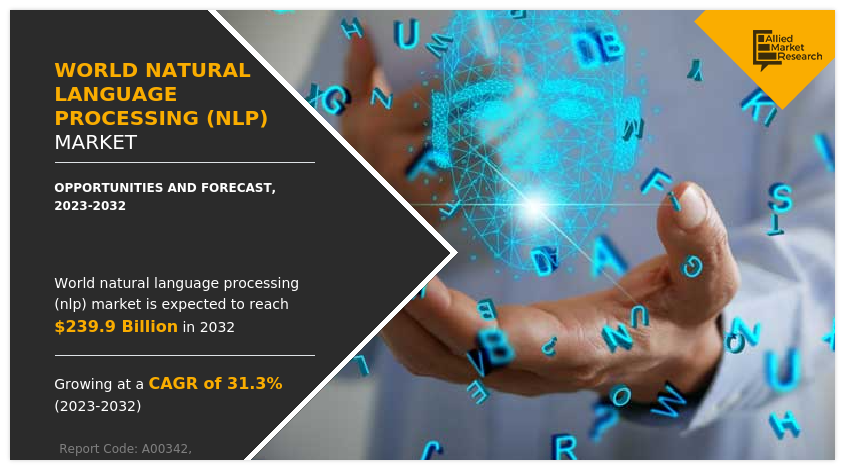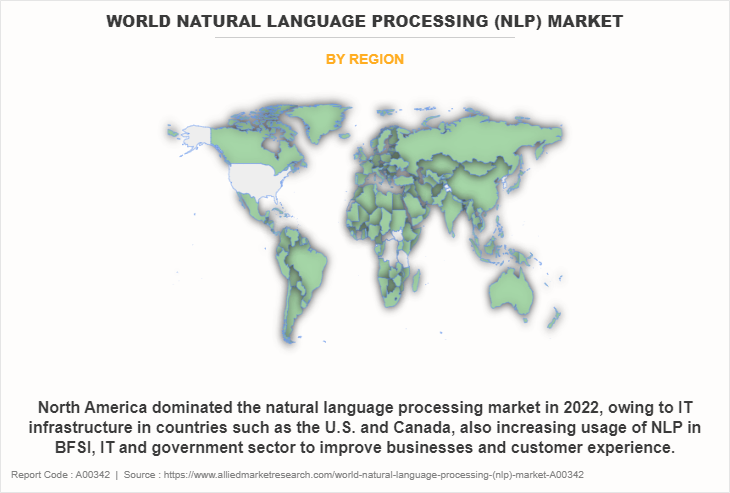Natural Language Processing (NLP) Market Insights, 2032
The global natural language processing (NLP) market size was valued at USD 16.2 billion in 2022, and is projected to reach USD 239.9 billion by 2032, growing at a CAGR of 31.3% from 2023 to 2032.
The surge in increasing automation as a result of the integration of NLP with deep learning (DL) and machine learning (ML), drive the market growth. In addition, growing demand for smart devices, and increasing demand for advanced text analytics drive the growth of the NLP market size and increase the natural language processing market size. However, complexities due to the usage of code-mixed language while implementing NLP solutions is expected to hamper the growth of the market. Furthermore, increase in automation as a result of the integration of NLP with deep learning and machine learning (ML) and rise in investments in the healthcare sector are expected to create lucrative opportunities for natural language processing market forecast.

On the contrary, the natural language processing market is expected to offer numerous opportunities for new players in the market. Rise in adoption of NLP in the finance and banking sector, has led to the ability to enhance operations by detecting fraudulent activities through the analysis of transaction data and customer interactions. In addition, it can automate the extraction and analysis of data from financial statements, contracts, and reports, making operations more efficient. Furthermore, NLP tools can analyze news articles, social media, and reports to understand market sentiment, helping to shape trading strategies. Furthermore, in the education and e-learning sector, NLP enables enhance learning experiences by creating intelligent tutoring systems that analyze student performance and adapt content accordingly. In addition, It can also assist educators and students by automatically summarizing long articles, research papers, and textbooks.
Moreover, the integration of NLP has led to the development of language learning apps that focus on pronunciation, sentence construction, and grammar. Moreover, the increase in the use of NLP In the government and public services sector, provides enhance efficiency by automating responses to public queries, thereby improving communication. In addition, it helps to assist in digitizing and organize large volumes of unstructured data from various public records and documents. Furthermore, the surge in the adoption of NLP by businesses for real-time text analysis to gain insights from customer feedback, reviews, and social media post, helps in predicting trends, behaviors, and market changes by analyzing both past and current text data. Moreover, the increase in the use of NLP in the e-commerce and retail sector offers enhanced product search and discovery by better understanding user queries and improving product recommendations. In addition, the rise of using NLP in analyzing customer feedback, reviews, and social media posts, helps businesses understand customer preferences and improve their offerings. These factors are expected to offer lucrative opportunities for the market growth.
The natural language processing (NLP) is a part of artificial intelligence (AI) that enables the computer to interpret human language, obtain meaning, and make communication more convenient by using voice enabled artificial intelligence (AI) and conversational intelligence technologies. In addition, the NLP features such as autocorrect and autocomplete tool help analyze personal language patterns and identify the most appropriate suggestions for the individual users or public. Furthermore, natural language processing automates much of the physical process, and provides analytics and business intelligence for growth and helps to order and organize the processes.
In addition, growing data and increasing complexities in large businesses would open numerous opportunities for NLP industry in the market. Advertising and branding are two highly important strategies used by the natural language processing industry to promote firms. It gives the companies an opportunity to connect with the right customers. The natural language processing market is segmented into Component, Deployment Mode, Enterprise Size, Type, Industry Vertical.
Market Trends Insights:
The natural language processing market insights highlights that the maket is expected to witness several noteworthy trends in the market. One of the significant trends is the rsie in the adoption of NLP in the healthcare and medical industry to automate transcription services by converting speech to text and generating structured medical records, thereby reducing manual work. In addition, the increase in use of NLP helps to extract key information from clinical notes, supporting medical decisions. Furthermore, there is a growing trend toward the use of chatbots for patient queries and appointment scheduling. Moreover, the shift in preference toward the NLP-powered chatbots and virtual assistants helps in automating customer support processes, deployment costs risks and improving response times. In addition, there is growing trend toward the use NLP by businesses to analyze customer emotions from social media, reviews, and feedback, improving engagement, providing personalized product recommendations.
Another notable trend in the market is the increase in the use of NLP in developing real-time translation tools, enabling businesses to cater to a global audience and communicate more effectively. NLP-powered chatbots can converse in multiple languages, thereby expanding customer service reach to non-English speaking customers. In addition, there is growing trend toward the adoption of NLP in enhancing speech-to-text applications, such as voice assistants like Amazon's Alexa and Apple's Siri, improving speech recognition accuracy and enabling voice-based controls across various devices.
Moreover, another significant trend in the market is the use of NLP in social media monitoring. NLP tools can track conversations and identify brand sentiment, allowing companies to manage their reputation more effectively. In addition, NLP models like OpenAI's GPT are utilized for automated content creation, including writing articles, creating marketing content, and generating news summaries. Furthermore, the surge in the adoption of NLP tools to analyze resumes to match candidates with job descriptions improves recruitment efficiency.
For instance, on March 02, 2023, Kensho Technologies launched a new solution in its AI Toolkit, Kensho Classify. This Natural Language Processing (NLP) tool extracts value from extensive text and documents by enhancing content discoverability. It facilitates text analysis, intelligent searching, content suggestions, and efficient research and analysis.
Segment Review:
The natural language processing market is segmented on the basis of component, deployment mode, enterprise size, type, industry vertical, and region. By component, it is bifurcated into solution and services. By deployment mode, it is segregated into on-premises and cloud. By enterprise size, it is categorized into large enterprise and small and medium-sized enterprise. On the basis of type, it is segregated into statistical NLP, rule-based NLP, and hybrid NLP. By industry vertical, it is segregated into BFSI, IT and telecom, retail and e-commerce, healthcare, education, media and entertainment, and others. Region wise, it is analyzed across North America, Europe, Asia-Pacific, and LAMEA.
Competitive Analysis:
The key players operating in natural language processing industry include Apple Inc., Intel Corporation, SAS Institute Inc., SAP SE, Google LLC, Microsoft Corporation, Oracle Corporation, International Business Machines Corporation, Amazon Web Services, Inc., and Hewlett Packard Enterprise Development LP. Furthermore, it highlights the strategies of the key players to improve the natural language processing market share and sustain competition for NLP industry.

On the basis of component, solution segment dominated the NLP market in 2022 and is expected to maintain its dominance in the upcoming years owing to allows businesses to improve financial workflows, increase efficiency, and lower expenses all at the same time propels the natural language processing market growth significantly. However, the service segment is expected to witness the highest growth, owing to provide organizations to integrate the artificial intelligence (AI)-driven NLP services for building AI chat-bot, intent classification, entity recognition, extract data from PDF, text categorization, sentimental analysis, extract insights using NLP, and Internet of Things (IoT) development among others.
Recent Product Launches in the Market:
- On November 21, 2024, InMoment launched an AI-Powered Journey Insights Tool that uses NLP and large language models to map customer touchpoints across all channels and journey stages. This tool provides industry-specific insights, competitive analysis, and a holistic view of the customer journey, helping organizations improve customer satisfaction by identifying and addressing friction points.
- On January 6, 2025 , S&P Global has acquired ProntoNLP, a leading provider of Generative Artificial Intelligence (GenAI) tooling. This acquisition aims to enhance S&P Global's textual data analytics capabilities by integrating ProntoNLP's proprietary NLP and large language models (LLMs) for efficient analysis of unstructured financial data1. ProntoNLP will be integrated into the S&P Global Market Intelligence division, bolstering their ability to deliver actionable insights from both structured and unstructured data.
- On March 2, 2023, Kensho Technologies, a company under S&P Global, launched a new Natural Language Processing (NLP) solution called Kensho Classify. This solution is designed to conceptually understand and classify documents, making vast amounts of text more discoverable and enabling efficient analysis. Kensho Classify is particularly tuned for complex business and finance use cases, allowing users to find concepts and topics within documents quickly and accurately.
Regional Review:

On the basis of region, North America natural language processing market dominated the market in 2022 and is expected to maintain its dominance in upcoming years owing to developed IT infrastructure in countries such as the U.S. and Canada, also increasing usage of NLP in BFSI, IT and government sector to improve businesses and customer experience. However, the Asia Pacific region is expected to grow at the highest CAGR during the forecast period, owing to adoption of process automation across all industry verticals to enhance customer engagement and increase effectiveness of IT infrastructure in Asia-Pacific.
The report focuses on growth prospects, restraints, and analysis of the global natural language processing market trends. The study provides Porter’s five forces analysis to understand the impact of various factors, such as bargaining power of suppliers, competitive intensity of competitors, the threat of new entrants, threat of substitutes, and bargaining power of buyers on the global natural language processing market share.
Top Impacting Factors:
Increase in Automation as a Result of the Integration of NLP with Deep Learning (DL) and Machine Learning (ML)
The NLP has boomed as artificial intelligence (AI) and machine learning (ML) technologies become more widely used in various industries. The AI-driven natural language processing searches empower businesses to keep up-to-date with the latest data, automate repetitive tasks, internal processes and improve productivity. In addition, it improves customer experience through predictive analytics and automate functions where manual processes were previously required and personalize user-interface capabilities. Enterprises are deploying AI as it provides personalization solutions through the use of technologies such as natural language processing (NLP), which can be engaged by human speech and voice commands.
Moreover, artificial intelligence (AI) accelerates numerous operations across the business and internal processes to achieve faster responses, produce quick projections, and provide rapid responsiveness. Furthermore, for improved security, artificial intelligence (AI) uses its unique capability of machine learning (ML) to recognize patterns, the ability to quickly identify and remediate possible risks with built-in self-recovery improves NLP security. Furthermore, the integration of ML and deep learning (DL) with NLP automates all business operations, which helps to handle growing business concerns about cost, scalability, and security more easily while protecting vital data as well as enhances the economic infrastructure.
For instance, on March 27, 2023, Amazon partnered with IIT Bombay to initiate the Amazon IIT–Bombay AI-ML Initiative. This project aims to promote advanced research in machine learning and artificial intelligence, focusing on language, speech, and multimodal-AI fields. This long-term partnership between Amazon and IIT Bombay supports research projects, PhD scholarships, and community gatherings through the artificial intelligence/machine learning initiative.
Growth in Use of Internet and Connected Devices
Technological advancement and digital transformation have altered industries to conduct business and communicate with their customers. NLP has been shown to be extremely useful in facilitating interactions between users and systems or machines. The growing natural language processing demand for voice-based solutions that interface with NLP-based applications provides users with enhanced functionalities such as verbal command capability and instant query management, increases the demand for internet and connected devices.
Opportunity:
The Explosive Growth of NLP Technology
The NLP market research highlights that the market is anticipated to witness significant growth, driven by advancements in AI-powered technologies and increasing demand for natural language searches across various industries. With businesses increasingly relying on AI-driven solutions, NLP has emerged as a critical tool for enabling machines to understand, interpret, and respond to human language in a more intuitive and efficient manner.
The NLP market is expected to witness substantial growth, as NLP technology continues to evolve, facilitating better communication between humans and machines. This growth can be attributed to the increasing adoption of NLP technologies in applications such as virtual assistants, chatbots, and sentiment analysis. In addition, the surge in the adoption of NLP technology in creating automated content generation, supports market expansion, driving the natural language processing NLP market.
AI-powered solutions are central to this transformation, enabling more accurate and effective natural language searches. By improving the precision of search results and providing users with more relevant information, these solutions are significantly enhancing user experiences. As companies strive, maximizing the value of existing installations by optimizing NLP technologies is essential to reduce deployment costs and mitigate associated risks.
In addition to AI-driven advancements, the market is expected to witness both organic and inorganic growth strategies. Companies are focusing on developing cutting-edge NLP technology, investing in research and development, and forming strategic partnerships to expand their reach. These efforts are complemented by mergers and acquisitions, which allow businesses to scale and integrate advanced NLP capabilities into their existing product portfolios.
The ongoing demand for improved language processing capabilities is pushing the boundaries of NLP, positioning it as a key enabler of digital transformation across sectors such as healthcare, finance, retail, and customer service. As NLP technology continues to mature, its applications are expected to become even more diverse, driving further market growth.
Increasing Adoption in the Healthcare Sector
The increase in the adoption of natural language processing in the healthcare sector presents substantial opportunities to enhance both patient care and operational efficiency. NLP helps to significantly reduce the administrative burden on healthcare professionals by automating the extraction of information from unstructured data, such as clinical notes and medical records. This allows for faster, more accurate documentation and enables healthcare providers to focus more on patient care. In addition, NLP helps to assist in diagnostics by analyzing large volumes of patient data, medical literature, and research papers to identify trends, recommend treatments, and improve decision-making. This leads to more personalized and timely care, enhancing patient outcomes. NLP also plays a critical role in improving patient engagement.
Furthermore, virtual assistants and chatbots powered by NLP help to provide patients with instant access to medical information, help schedule appointments, and even offer medication reminders, making healthcare more accessible. In addition, NLP supports medical research by streamlining the extraction of valuable insights from extensive scientific literature and clinical trials, accelerating the discovery of new treatments. As healthcare continues to digitize, the integration of NLP offers the potential for significant improvements in healthcare delivery, patient interaction, and research, driving the growth of the NLP market in this sector.
Governments Support:
Government support plays a essential role in the growth of the Natural Language Processing (NLP) market, fostering innovation and ensuring the responsible development of AI technologies. Governments globally are recognizing the economic and strategic importance of NLP and artificial intelligence (AI). In countries like the United States, the government has established initiatives such as the National AI Initiative Act to drive research funding and ensure a competitive edge in AI, including NLP. Similarly, China has heavily invested in AI, aiming to become a global leader by 2030 through government-funded research and support for tech startups.
In addition, governments are establishing regulations to address concerns regarding data privacy, fairness, and bias in NLP systems. For instance, the European Union's General Data Protection Regulation (GDPR) has set standards that influence how NLP technologies operate in the region, ensuring ethical practices in data usage.
Moreover, governments are increasing support in building a skilled workforce through investments in AI education and training programs. By supporting universities and research institutions, they help cultivate the talent needed to develop and maintain NLP technologies. Overall, government involvement is essential in driving the growth of the NLP market, ensuring innovation while addressing ethical considerations.
Key Benefits for Stakeholders:
- This report provides a quantitative analysis of the market segments, current NLP market trends, estimations, and dynamics of the NLP market analysis from 2022 to 2032 to identify the prevailing world natural language processing market opportunities.
- The natural language processing market research is offered along with information related to key drivers, restraints, and opportunities.
- Porter's five forces analysis highlights the potency of buyers and suppliers to enable stakeholders make profit-oriented business decisions and strengthen their supplier-buyer network.
- In-depth analysis of the world natural language processing market segmentation assists to determine the prevailing market opportunities and NLP market size.
- Major countries in each region are mapped according to their revenue contribution to the global market and natural language processing market share.
- Market player positioning facilitates benchmarking and provides a clear understanding of the present position of the market players.
- The report includes the natural language processing market analysis of the regional as well as global world natural language processing market trends, key players, market segments, application areas, and natural language processing market growth strategies.
World Natural Language Processing (NLP) Market Report Highlights
| Aspects | Details |
| Market Size By 2032 | USD 239.9 billion |
| Growth Rate | CAGR of 31.3% |
| Forecast period | 2022 - 2032 |
| Report Pages | 425 |
| By Deployment Mode |
|
| By Enterprise Size |
|
| By Type |
|
| By Industry Vertical |
|
| By Component |
|
| By Region |
|
| Key Market Players | Intel Corporation, SAP SE, Oracle Corporation, Hewlett Packard Enterprise Development LP, Microsoft Corporation, Amazon Web Services, Inc., SAS Institute Inc., Google LLC, Apple Inc., International Business Machines Corporation |
Analyst Review
Over time, businesses have seen various changes in the business processes, operations, and industrial automation. Moreover, businesses are shifting towards the digital platform and increasing implementation of Industry 4.0 to cope with ongoing tough business competition, which creates the need for seamless solutions and platforms to meet these requirements. This increases eventually escalates the adoption of NLP platform in manufacturing, healthcare, pharmaceutical, and among others industry sectors rapidly. Furthermore, the NLP has boomed as artificial intelligence (AI) and machine learning (ML) technologies become more widely used in various sectors. The AI-driven NLP empowers businesses to keep up to date with the latest data, automate repetitive tasks, internal processes and improve productivity. In addition, it improves customer experience through predictive analytics and automate functions where manual processes were previously required and personalize user-interface capabilities. In addition, it provides customized and healthcare specific applications that will help the industry by offering higher-level quality services to their customers. These advantages are expected to provide lucrative opportunities for the market growth in the upcoming years. Nevertheless, prominent market players are exploring new technologies and applications to meet the increase in customer demands. Product launches, collaborations, and acquisitions are expected to enable them to expand their product portfolios and penetrate different regions. Emerging economies provide lucrative opportunities to market players for growth or expansion.
For instance, in June 2022, Apple introduced a plan to provide an open-source reference PyTorch version of the transformer architecture accessible, enabling developers globally to install Transformer models on Apple devices easily.
The global natural language processing (NLP) market size was valued at USD 16.2 billion in 2022, and is projected to reach USD 239.9 billion by 2032
The global natural language processing market is projected to grow at a compound annual growth rate of 31.3% from 2023-2032 to reach USD 239.9 billion by 2032
The key players that operate in the market Apple Inc., Intel Corporation, SAS Institute Inc., SAP SE, Google LLC, Microsoft Corporation, Oracle Corporation, International Business Machines Corporation, Amazon Web Services, Inc., and Hewlett Packard Enterprise Development LP.
North America the largest regional market for Natural Language Processing (NLP) Market.
Increase in automation as a result of the integration of NLP with deep learning (DL) and machine learning (ML), rise in demand for predictive analytics to reduce risks and identify growth opportunities. and growth in use of internet and connected devices the upcoming trends of Natural Language Processing (NLP) Market in the world.
Loading Table Of Content...
Loading Research Methodology...


